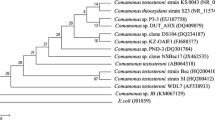Abstract
Two strains of Alcaligenes denitrificans, designated BRI 3010 and BRI 6011, were isolated from polychlorinated biphenyl (PCB)-contaminated soil using 2,5-dichlorobenzoic acid (2,5-DCBA) and 2,4-DCBA, respectively, as sole carbon and energy sources. Both strains degraded 2-chlorobenzoic acid (2-CBA), 2,3-DCBA, and 2,5-DCBA, and were unable to degrade 2,6-DCBA. BRI 6011 alone degraded 2,4-DCBA. Growth of BRI 6011 in yeast extract and 2,6-DCBA induced pyrocatechase activity, but 2,6-DCBA was not degraded, suggesting the importance of an unsubstituted carbon six of the aromatic ring. Metabolism of the chlorinated substrates resulted in the stoichiometric release of chloride, and degradation proceeded by intradiol cleavage of the aromatic ring. Growth of both strains on 2,5-DCBA induced pyrocatechase activities with catechol and chlorocatechols as substrates. In contrast to dichlorobenzoic acids, growth on 2-CBA, benzoic acid, mono- and dihydroxybenzoic acids induced a pyrocatechase activity against catechol only. Although 2,4-DCBA was a more potent inducer of both pyrocatechase activities, its utilization by BRI 6011 was inhibited by 2,5-DCBA. Specific uptake rates using resting cells were highest with 2-CBA, except when the resting cells had been previously grown on 2,5-DCBA, in which case 2,5-DCBA was the preferred substrate. The higher rates of 2,5-DCBA uptake obtained by growth on that substrate, suggested the existence of a separately induced uptake system for 2,5-DCBA.
Similar content being viewed by others
References
Baggi G (1985) Richerche sulla degradazione di acidi clorobenzoici. Ann Microbiol 35: 71–78
Doetsch RN (1981) Determinative methods of light microscopy. In: Gerhardt P, Murray RGE, Costilow RN, Nester EW, Wood WA, Krieg NR, Phillips GB (eds) Manual of methods for general bacteriology. American Society for Microbiology, Washington, DC, pp 21–33
Dolfing J, Tiedje JM (1987) Growth yeild increase linked to reductive dechlorination in a defined 3-chlorobenzoate degrading methanogenic coculture. Arch Microbiol 149: 102–105
Dorn E, Knackmuss H-J (1978a) Chemical structure and biodegradability of halogenated aromatic compounds. Two catechol 1,2-dioxygenases from a 3-chlorobenzoate-grown Pseudomonad. Biochem J 174: 73–84
Dorn E, Knackmuss H-J (1978b) Chemical structure and biodegradability of halogenated aromatic compounds. Substituent effects on 1,2-dioxygenation of catechol. Biochem J 174: 85–94
Engesser KH, Schulte P (1989) Degradation of 2-bromo-, 2-chloro-and 2-fluorobenzoate by Pseudomonas putida CLB 250. FEMS Microbiol Lett 60: 143–148
Florence TM, Farrar YT (1971) Spectrophotometric determination of chloride at the parts-per-billion level by the mercury(II) thiocyanate method. Anal Chem Acta 54: 373–377
Grishchenkov VG, Fedechkina IE, Baskunov BP, Anisimova LA, Boronin AM, Golovleva LA (1983) Degradation of 3-chlorobenzoic acid by a Pseudomonas putida strain. Mikrobiologiya 52: 771–776
Hartmann J, Reineke W, Knackmuss H-J (1979) Metabolism of 3-chloro-, 4-chloro-, and 3,5-dichlorobenzoate by a Pseudomonas. Appl Environ Microbiol 37: 421–428
Hickey WJ, Focht DD (1989) Metabolism of mono- and dichlorobenzoate by Pseudomonas aeruginosa strain JB2. Abstr Annu Meet Am Soc Microbiol 1989 K-64 p. 255
Keil H, Klages U, Lingens F (1981) Degradation of 4-chlorobenzoate by Pseudomonas sp. CBS3: Induction of catabolic enzymes. FEMS Microbiol Lett 10: 213–215
Kim CJ, Maier WJ (1986) Acclimation and biodegradation of chlorinated organic compounds in the presence of alternate substrates. J Water Pollut Control Fed 58: 157–164
Marks TS, Smith ARW, Quirk AV (1984) Degradation of 4-chlorobenzoic acid by Arthrobacter sp. Appl Environ Microbiol 48: 1020–1025
Markwell MAK, Haas SM, Bieber LL, Tolbert NE (1978) A modification of the Lowry procedure to simplify protein determination in membrane and lipoprotein samples. Anal Biochem 87: 206–210
Muller R, Thiele J, Klages V, Lingens F (1984) Incorporation of [18O] water into 4-hydroxybenzoic acid in the reaction of 4-chlorobenzoate dehalogenase from Pseudomonas sp. CBS3. Biochem Biophys Res Commun 124: 178–182
Ngai K-L, Ornston LN (1988) Abundant expression of Pseudomonas genes for chlorocatechol metabolism. J Bacteriol 170: 2412–2413
Nozaki M (1970) Metapyrocatechase (Pseudomonas). In: Tabor H, Tabor CW (eds) Methods in enzymology, vol 27A. Academic Press, New York, pp 522–525
Reineke W, Knackmuss H-J (1978) Chemical structure and biodegradability of halogenated aromatic compounds. Substituent effects on 1,2-dioxygenation of benzoic acid. Biochim Biophys Acta 542: 412–423
Taylor BP, Hearn WL, Pincus S (1979) Metabolism of monofluoro-and monochlorobenzoates by a dentrifying bacterium. Arch Microbiol 122: 301–306
Topp E, Crawford RL, Hanson RS (1988) Influence of readily metabolizable carbon on pentachlorophenol metabolism by a pentachlorophenol-degrading Flavobacterium sp. Appl Environ Microbiol 54: 2452–2459
van den Tweel WJJ, Kok JB, de Bont JAM (1987) Reductive dechlorination of 2,4-dichlorobenzoate to 4-chlorobenzoate and hydrolytic dehalogenation of 4-chloro-, 4-bromo-, and 4-iodobenzoate by Alcaligenes denitrificans NTB-1. Appl Environ Microbiol 53: 810–815
Author information
Authors and Affiliations
Rights and permissions
About this article
Cite this article
Miguez, C.B., Greer, C.W. & Ingram, J.M. Degradation of mono- and dichlorobenzoic acid isomers by two natural isolates of Alcaligenes denitrificans . Arch. Microbiol. 154, 139–143 (1990). https://doi.org/10.1007/BF00423323
Received:
Accepted:
Issue Date:
DOI: https://doi.org/10.1007/BF00423323




